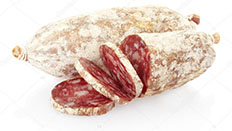Meats and Sausages
Salame S. Angelo
Salame S. Angelo is Italian salami produced in the municipality of Sant'Angelo di Brolo. The sausage is stuffed into variety of pork casings and it is distinguished by its irregular, cylindrical shape covered with white mold. Its slices are red in color with white particles of fat and it has a delicate and distinctive aroma and a slightly spicy and fragrant taste
| Meats | Metric | US |
|---|---|---|
| Lean pork - shoulder, loin, ham, trimmed belly* | 1000 g | 2.2 lb |
Ingredients per 1000g (1 kg) of meat
| Sea salt | 28 g | 5 tsp |
| Cure #2 | 3.0 g | 1/2 tsp |
| Pepper | 1.0 g | 1/2 tsp |
| Dextrose | 3.0 g | 1/2 tsp |
| Sugar | 2.0 g | 1/3 tsp |
| Starter culture, T-SPX | 0.12 g | use scale |
Instructions
- Cut meat into 3/8” 10 mm cubes.
- 30 minutes before mixing dissolve starter culture in 1 tablespoon de-chlorinated water.
- Mix meat with all ingredients.
- Stuff into large 40-60 mm hog casings.
- Ferment at 20º C (68º F) for 72 hours, 90 → 85% humidity.
- Dry at 15-12º C (59-54º F), 85→75% decreasing humidity for 30-45 days. The sausage is dried until around 30-35% in weight is lost.
- Store sausages at 10-15º C (50-59º F), <75% humidity.
Notes
* Fat content must stay below 20%.
History
Proof of Salame S. Angelo's reputation and sales may be found in the sales invoices for Salame S. Angelo dating back to 10 January 1982. The master’s dissertation entitled ‘Salame S. Angelo: Prodotto di Nicchia’ (Salame S. Angelo: a niche product) shows that, for many years, there has existed a district in the production area set out in the product specification well-known and reputed not only for the quality and organoleptic characteristics of the product but also for the expertise of local inhabitants who have carefully passed down from generation to generation the techniques of producing Salame S. Angelo.
Production
Raw materials used and eligible for producing Salame S. Angelo PGI must include fresh meat from selected breeds of local pigs. The pigs must receive optimum nutrition, be exclusively of EU Member State origin and must have reached a weight of at least 125 kg before slaughter. The raw material used must be delivered to production premises in whole half carcasses (including the head), and the use of frozen or deep-frozen meat is strictly prohibited.
Meat: the rear leg-ham part, loin, shoulder, neck, and trimmed belly. The proportion of meat to fat must be no more than 100/20, i.e. no more than 20% fat. The use of lard is strictly prohibited.
Ingredients: sea salt, black semi-cracked pepper, potassium nitrate(E252).
Processing: The pieces of meat and fat comprising the sausage mix must be cut ‘a punta di coltello’, i.e. using the tip of a knife. Alternatively, a specific dicing machine producing 12 millimeter-sized cubes may be used during this stage. The cut/diced meat is mixed with all ingredients and stuffed into casing. The weight of Salame S. Angelo varies depending on the diameter and the length of the sausage. The diameter of the casing is the factor that largely affects the time of drying and maturing. A white mold is expected to cover the sausage.
Regular pork casing (felllata, sottocularino) : 200 – 700 g, maturing at least 30 days; pork bung (cularino): 700 – 1,500 g, maturing time at least 50 days; pork blind cap (sacco): 1000 – 3,500 g, maturing time at least 60 days. When the naturing is completed, Salame S.Angelo exhibits the following characteristics: pH (acidity level) between 5.1 and 6.2 and the Aw (water activity) between 0.81 and 0.96.


















